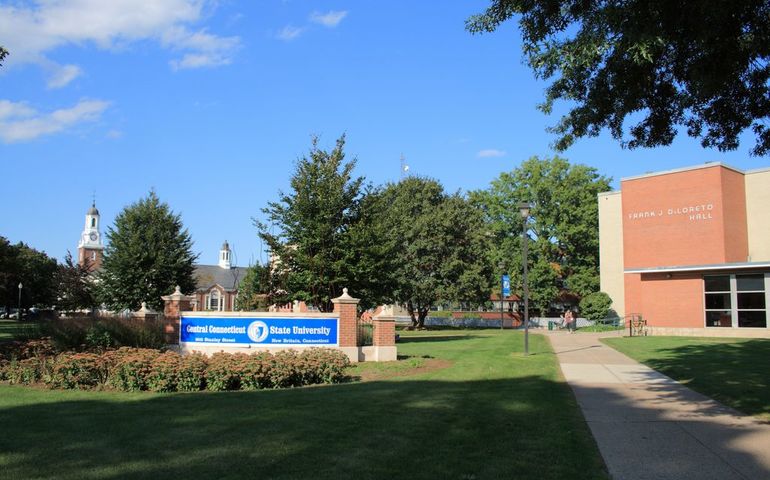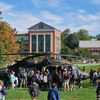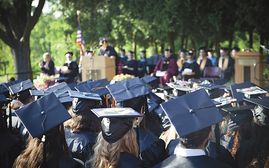Processing Your Payment
Please do not leave this page until complete. This can take a few moments.
- News
-
Editions
View Digital Editions
Biweekly Issues
- May 13, 2024
- April 29, 2024
- April 15, 2024
- April 1, 2024
- March 18, 2024
- March 4, 2024
- February 19, 2024
- February 5, 2024
- January 22, 2024
- + More
Special Editions
- Lists
- Viewpoints
- HBJ Events
- Business Calendar
- Custom Content
‘Small gathering’ at CCSU results in weekly COVID rate above 3 percent
 Photo | Wikimedia Commons
Central Connecticut State University's campus in New Britain.
Photo | Wikimedia Commons
Central Connecticut State University's campus in New Britain.
Nearly a month into the school year, Central Connecticut State University’s weekly rate of student COVID-19 cases is above 3%, making it an outlier in the state university system.
In the last two weeks, CCSU’s residential student and staff positivity rates increased from 3.02% to its highest last week at 3.44%, with a cumulative rate of 2.31%. The school linked the spike in positive cases last week to a “small outdoor gathering” of 15 students at an off-campus home rented by students.
CCSU President Zulma Toro said the university was able to contain the spread because some of the people who attended the party lived together, which meant they were able to quarantine together. The university then located the other people who attended the gathering through contact tracing.
Toro said she is proud of the system the university has in place to contain COVID, despite the higher percentage of cases compared to many other Connecticut universities and colleges.
“I am not saying that 15 cases is not something I should not be concerned about. I will be concerned even with one case, to be honest,” she said. “But the fact that when I sit down with my team and we can track every case back to a small gathering, then I know where each case came from. I think that I feel better because I know that we have contained the spread.”
One strategy CCSU uses to track cases is requiring that every faculty, administrator, staff and student take a survey every day they plan to be on the campus. The survey is simple, Toro said, and asks two questions: Does the person have any symptoms, and have they been exposed to anyone who has the virus?
If the answer is yes to either of those questions, the individuals will then be contacted by the university’s contact tracing team, who will then track that student or faculty member.
But mitigation efforts look different at other institutions — as do their COVID rates.
For the first time since reopening its Storrs campus in August, UConn’s COVID-19 rate has shot above 1% among on-campus students.
There were 60 active positive cases on Tuesday at the Storrs campus out of 5,000 residential students. The university announced Saturday that students in another dorm on the Storrs campus, Eddy Hall, are quarantined due to rising cases among residents there.
Last month, the university also placed every resident in Garrigus Hall under quarantine after dozens of students living there tested positive for COVID. The quarantine for Garrigus Hall has since been lifted, but residents at The Oaks, an off-campus apartment complex, were instructed to self-quarantine on Sept. 11 after concerns of an outbreak.
The university gave an update Monday regarding The Oaks, saying the quarantine reduced the spread of the virus in the complex by more than half. UConn’s Student Health and Wellness Center tested nearly 50% of all residents there since placing them on quarantine and the remaining will be contacted this week for additional testing.
UConn has tested students regularly since August to keep track of COVID-19 cases both on its main campus and satellite campuses and has also taken the initiative to test wastewater at Storrs to track the presence of the virus on campus.
“We have consistently reported low infection rates of around 1% in our residential community and we are confident in the continued efforts of the Oaks residents,” UConn officials said in a statement Monday. “Remember, spread occurs at UConn among those who are not consistently wearing masks and not keeping 6 feet of distance from one another.”
About 10% to 25% of residential students have been randomly selected for weekly testing at the four state universities in order to keep track of trends and cases. In order to continue mitigation efforts next year, the CSCU system announced Monday that it has cancelled spring break in 2021 and will begin the spring semester a week later to decrease the chance of people bringing COVID-19 back to campus.
UConn’s neighbor in the northeastern corner of the state, Eastern Connecticut State University, has had few cases since reopening in August and has a cumulative positivity rate of 0.0023%. The school has only had one positive resident student case and, as of Friday, there were nine commuter student cases. ECSU is smaller than UConn, with roughly 2,000 full-time residential undergraduate students.
Southern Connecticut State University in New Haven also has reported a low number of cases, with three positive residential student cases, 11 positive commuter students and one reported staff case, for a cumulative rate of 0.35%.
Western Connecticut State University had to temporarily close at the end of August due to a spike in positive cases in Danbury. In-person classes began and students began moving into dorms last week but residential students were required to submit a negative COVID-19 test to the university before doing so.
Since Sept. 7, the school reported only one positive residential staff and student case, two positive commuter cases and one self-reported faculty case.
Like the public institutions, private schools are using similar methods to help reduce potential spread of the virus.
Fairfield University’s positive COVID-19 numbers last week were similar to CCSU in that 17 of 470 students tested positive for the disease, resulting in a COVID rate of 3.6%. The university has implemented a daily health monitoring survey for students, faculty and staff to complete before being allowed on campus. The university is also testing a random sample of 5% to 10% of the campus population.
Related Content

2022 Giving Guide
This special edition informs and connects businesses with nonprofit organizations that are aligned with what they care about. Each nonprofit profile provides a crisp snapshot of the organization’s mission, goals, area of service, giving and volunteer opportunities and board leadership.
Learn more
Subscribe
Hartford Business Journal provides the top coverage of news, trends, data, politics and personalities of the area’s business community. Get the news and information you need from the award-winning writers at HBJ. Don’t miss out - subscribe today.
Subscribe
2024 Book of Lists
Delivering Vital Marketplace Content and Context to Senior Decision Makers Throughout Greater Hartford and the State ... All Year Long!
Read Here-
2022 Giving Guide
This special edition informs and connects businesses with nonprofit organizations that are aligned with what they care about. Each nonprofit profile provides a crisp snapshot of the organization’s mission, goals, area of service, giving and volunteer opportunities and board leadership.
-
Subscribe
Hartford Business Journal provides the top coverage of news, trends, data, politics and personalities of the area’s business community. Get the news and information you need from the award-winning writers at HBJ. Don’t miss out - subscribe today.
-
2024 Book of Lists
Delivering Vital Marketplace Content and Context to Senior Decision Makers Throughout Greater Hartford and the State ... All Year Long!
ABOUT
ADVERTISE
NEW ENGLAND BUSINESS MEDIA SITES
No articles left
Get access now
In order to use this feature, we need some information from you. You can also login or register for a free account.
By clicking submit you are agreeing to our cookie usage and Privacy Policy
Already have an account? Login
Already have an account? Login
Want to create an account? Register
Get access now
In order to use this feature, we need some information from you. You can also login or register for a free account.
By clicking submit you are agreeing to our cookie usage and Privacy Policy
Already have an account? Login
Already have an account? Login
Want to create an account? Register










0 Comments